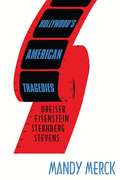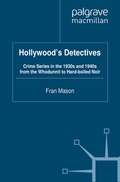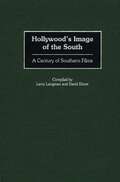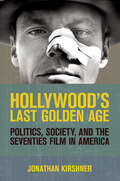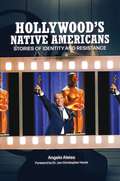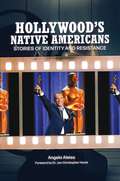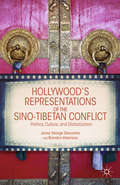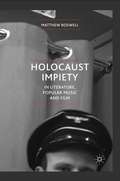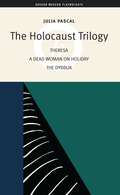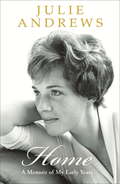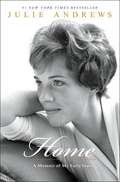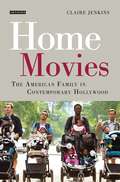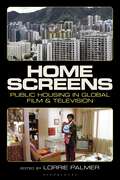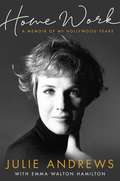- Table View
- List View
Hollywood Victory: The Movies, Stars, and Stories of World War II (Turner Classic Movies)
by Christian Blauvelt Turner Classic MoviesThis is the story of the myriad ways in which Hollywood was "enlisted" into World War II. Studios and stars were recruited to aid in the war effort, and whether through personal ideologies or to remain in good standing with the government and general public, most were willing participants. Hollywood's support of the war effort included:War films supporting the Allied effortMusicals and comedies that promoted the "Good Neighbor Policy" with our allies to the south -- Central and South AmericaUSO tours that sent stars out to sell war bonds and entertain the troops around the country and abroad"Homefront" films designed to boost the morale of troops overseasPin-ups-stars like Rita Hayworth, Betty Grable, and Lana Turner were painted on the sides of bomber jets and posted all over barracks wallsStars themselves went to war -- Jimmy Stewart, Clark Gable, and many, many more saw active dutyThe USO Canteen: Organized by Bette Davis, this was a nightclub where soldiers could meet and mingle with their favorite starsFilmmakers like Orson Welles, Frank Capra, and John Ford took breaks from their work to make training films.In engaging, informative text with images throughout, the stories behind all of this and more come to life, giving readers a fresh perspective on both Hollywood and the perennially fascinating subject of World War II.
Hollywood's American Tragedies: Dreiser, Eisenstein, Sternberg, Stevens
by Mandy MerckTheodore Dreiser's dissection of the American dream, An American Tragedy, was hailed as the greatest novel of its generation. Now a classic of American literature, the story is one to which Hollywood has repeatedly returned. Hollywood's obsession with this tale of American greed, justice, religion and sexual hypocrisy stretches across the history of cinema. Some of cinema's greatest directors - Sergei Eisenstein, Josef von Sternberg and George Stevens - have attempted to bring this classic story to the screen. Subsequently, both Jean-Luc Godard and Woody Allen have returned to the story and to these earlier adaptations. Hollywood's American Tragedies is the first detailed study of this extraordinary sequence of adaptations. What it reveals is a history of Hollywood - from its politics to its cinematography - and, much deeper, of American culture and the difficulty of telling an American tragedy in the land of the American dream.
Hollywood's Ancient Worlds
by Jeffrey RichardsJeffrey Richards examines the cultural, social, economic and technological circumstances that dictated the rise and decline of each successive cycle of Ancient World epics, from the silent film era, to the "golden age" of the 1950s, right up to the present day (Gladiator, 300, Rome). Analysis reveals that historical films are always as much about the time in which they are made as they are about the time in which they are set. The ancient world is often used to deliver messages to the contemporary audience about the present: hostility to totalitarian regimes both Fascist and Communist, concern at the decline of Christianity, support for the new state of Israel, celebrations of equality and democracy, and concern about changing gender roles. The whole adds up to a fresh look at a body of films that people think they know, but about which they will learn a good deal more.
Hollywood's Detectives: Crime Series in the 1930s and 1940s from the Whodunnit to Hard-boiled Noir (Crime Files)
by F. MasonThe study of Hollywood detectives has often overlooked the B-Movie mystery series in favour of hard-boiled film. Hollywood's Detectives redresses this oversight by examining key detective series of the 1930s and 1940s to explore their contributions to the detective genre.
Hollywood's Image of the South: A Century of Southern Films (Bibliographies and Indexes in the Performing Arts)
by David Ebner Larry LangmanFrom the 1920s and 1930s, when American cinema depicted the South as a demi-paradise populated by wealthy landowners, glamorous belles, and happy slaves, through later, more realistic depictions of the region in films based on works by Erskine Caldwell, Tennessee Williams, William Faulkner, and Robert Penn Warren, Hollywood's view of the South has been as ever-changing as the place itself. This comprehensive reference guide to Southern films offers credits, plot descriptions, and analyses of how the stereotypes and characterizations in each film contribute to our understanding of a most contentious American time and place.Organized by subjects including Economic Conditions, Plantation Life, The Ku Klux Klan, and The New Politics, Hollywood's Image of the South seeks to coin a new genre by describing its conventions and attitudes. Even so, the Southern film crosses all known generic boundaries, including the comedy, the women's film, the noir, and many others. This invaluable guide to an under-recognized category of American cinema illustrates how much there is to learn about a time and place from watching the movies that aim to capture it.
Hollywood's Indies: Classics Divisions, Specialty Labels and American Independent Cinema (Edinburgh University Press)
by Yannis TzioumakisHollywood's Indies offers an in depth examination of the phenomenon of the classics divisions by tracing its history since the establishment of the first specialty label in 1980.
Hollywood's Last Golden Age: Politics, Society, and the Seventies Film in America
by Jonathan KirshnerBetween 1967 and 1976 a number of extraordinary factors converged to produce an uncommonly adventurous era in the history of American film. The end of censorship, the decline of the studio system, economic changes in the industry, and demographic shifts among audiences, filmmakers, and critics created an unprecedented opportunity for a new type of Hollywood movie, one that Jonathan Kirshner identifies as the "seventies film." In Hollywood’s Last Golden Age, Kirshner shows the ways in which key films from this period—including Chinatown, Five Easy Pieces, The Graduate, and Nashville, as well as underappreciated films such as The Friends of Eddie Coyle, Klute, and Night Moves—were important works of art in continuous dialogue with the political, social, personal, and philosophical issues of their times.These "seventies films" reflected the era’s social and political upheavals: the civil rights movement, the domestic consequences of the Vietnam war, the sexual revolution, women’s liberation, the end of the long postwar economic boom, the Shakespearean saga of the Nixon Administration and Watergate. Hollywood films, in this brief, exceptional moment, embraced a new aesthetic and a new approach to storytelling, creating self-consciously gritty, character-driven explorations of moral and narrative ambiguity. Although the rise of the blockbuster in the second half of the 1970s largely ended Hollywood’s embrace of more challenging films, Kirshner argues that seventies filmmakers showed that it was possible to combine commercial entertainment with serious explorations of politics, society, and characters’ interior lives.
Hollywood's Native Americans: Stories of Identity and Resistance (Non-ser.)
by Angela AleissThis book highlights the contributions and careers of Native Americans who have carved impressive careers in Hollywood, from the silent film era of the early 1900s to the present, becoming advocates for their heritage.This book explores how the heritage and behind-the-scenes activities of Native American actors and filmmakers helped shape their own movie images. Native artists have impacted movies for more than a century, but until recently their presence had passed largely unrecognized. From the silent era to contemporary movies, this book features leading Native American actors whose voices have reached a broad audience and are part of the larger conversation about the exploitation of underrepresented people in Hollywood.Each chapter highlights Native actors in lead or supporting roles as well as filmmakers whose movies were financed and distributed by Hollywood studios. The text further explores how a "pan-Indian heritage" that applies to all tribes in terms of spirituality, historical trauma, and a version of ceremony and storytelling have shaped these performers' movie identities. It will appeal to a wide range of readers, including fans of Westerns, history buffs of American popular cinema, and students and scholars of Native American studies.
Hollywood's Native Americans: Stories of Identity and Resistance
by Angela AleissThis book highlights the contributions and careers of Native Americans who have carved impressive careers in Hollywood, from the silent film era of the early 1900s to the present, becoming advocates for their heritage.This book explores how the heritage and behind-the-scenes activities of Native American actors and filmmakers helped shape their own movie images. Native artists have impacted movies for more than a century, but until recently their presence had passed largely unrecognized. From the silent era to contemporary movies, this book features leading Native American actors whose voices have reached a broad audience and are part of the larger conversation about the exploitation of underrepresented people in Hollywood.Each chapter highlights Native actors in lead or supporting roles as well as filmmakers whose movies were financed and distributed by Hollywood studios. The text further explores how a "pan-Indian heritage" that applies to all tribes in terms of spirituality, historical trauma, and a version of ceremony and storytelling have shaped these performers' movie identities. It will appeal to a wide range of readers, including fans of Westerns, history buffs of American popular cinema, and students and scholars of Native American studies.
Hollywood's New Radicalism: War, Globalisation and the Movies from Reagan to George W. Bush (Cinema and Society)
by Ben DickensonDescribed by Tony Garnett as 'an ambitious and refreshing book', Hollywood's New Radicalism is a timely and contentious account of the last twenty-five years of American cinema. Ben Dickenson tells the story of the corporate take-over of the movies in the 1970s, and the subsequent transformation of Hollywood into the dominant force in the global media industry. Writing from the intersection where politics, society and cinema meet, and using exclusive interviews with Hollywood personalities, he explores the radicalising effect of such changes on liberal filmmakers like Warren Beatty, Michael Moore and Sean Penn in the past decade. He demonstrates how left-wing messages smuggled their way into 1980s movies, found a fuller voice in independent American cinema during the 1990s and flirted with mainstream popularity at the start of the new millennium. Bringing the story up to and through the 2004 Presidential election, he reveals how important Hollywood figures have become key members of a vigorous left–wing opposition to George W. Bush's Presidency. 'Here's a book that explains how the industry we're in really works and how some of us try to get a human message through the system. Without question an enjoyable and stimulating read.' – Ed AsnerAmbitious and refreshing. Ben Dickenson displays a rare and welcome use of political ideas, to make sense of Hollywood beyond its trivial surface.' – Tony Garnett
Hollywood's Representations of the Sino-Tibetan Conflict: Politics, Culture, and Globalization
by J. Daccache B. ValerianoUsing film as a lens though which we can witness the global transformations in politics, economy, culture, and communication, this book analyzes Hollywood's shift in its depictions of China and Tibet.
Hollywood's Stephen King
by T. MagistraleFor the past three decades, Hollywood has faithfully adapted much of Stephen King's fiction into film. Of the many major films that have been made, not one has lost money. Part of this may be explained in terms of King's own popularity in American culture; he has been, after all, a best-selling writer since the late 1970s. But more interesting is what this cinematic fascination reveals about postmodern American culture. In the first overview of Hollywood's major cinematic interpretations of Stephen King, Tony Magistrale examines the various thematic, narrative, and character interconnections that highlight the relationships among his films. Opening with a revealing interview with Stephen King, the book takes us through chapters that explore such popular films as Stand By Me, Misery, The Shining, The Green Mile, and The Shawshank Redemption among others.
Holocaust Impiety in Literature, Popular Music and Film
by M. BoswellSurveying irreverent and controversial representations of the Holocaust - from Sylvia Plath and the Sex Pistols to Quentin Tarantino and Holocaust comedy - Matthew Boswell considers how they might play an important role in shaping our understanding of the Nazi genocide and what it means to be human.
The Holocaust Trilogy: The Dybbuk, Dead Woman On Holiday, Theresa (Oberon Modern Playwrights)
by Julia PascalIncludes the plays Theresa, A Dead Woman on Holiday and The DybbukPresented as a trilogy at the New End Theatre in 1995 before touring much of Europe, The Dybbuk pays homage to Anski’s great Russian classic. Set in a ghetto in Eastern Europe in 1942, it traces the final moments of five irreligious Jews. A Dead Woman on Holiday is a love story set during the Nuremberg trials. Theresa is based on secret research into the Channel Island occupation by the Nazis and the collaboration of the residents with the Holocaust. The play is still banned there.
The Holy Fool in European Cinema (Routledge Studies in Religion and Film)
by Alina G. BirzacheThis monograph explores the way that the profile and the critical functions of the holy fool have developed in European cinema, allowing this traditional figure to capture the imagination of new generations in an age of religious pluralism and secularization. Alina Birzache traces the cultural origins of the figure of the holy fool across a variety of European traditions. In so doing, she examines the critical functions of the holy fool as well as how filmmakers have used the figure to respond to and critique aspects of the modern world. Using a comparative approach, this study for the first time offers a comprehensive explanation of the enduring appeal of this protean and fascinating cinematic character. Birzache examines the trope of holy foolishness in Soviet and post-Soviet cinema, French cinema, and Danish cinema, corresponding broadly to and permitting analysis of the three main orientations in European Christianity: Orthodox, Catholic, and Protestant. This study will be of keen interest to scholars of religion and film, European cinema, and comparative religion.
The Holy Fool in European Cinema (Routledge Studies in Religion and Film)
by Alina G. BirzacheThis monograph explores the way that the profile and the critical functions of the holy fool have developed in European cinema, allowing this traditional figure to capture the imagination of new generations in an age of religious pluralism and secularization. Alina Birzache traces the cultural origins of the figure of the holy fool across a variety of European traditions. In so doing, she examines the critical functions of the holy fool as well as how filmmakers have used the figure to respond to and critique aspects of the modern world. Using a comparative approach, this study for the first time offers a comprehensive explanation of the enduring appeal of this protean and fascinating cinematic character. Birzache examines the trope of holy foolishness in Soviet and post-Soviet cinema, French cinema, and Danish cinema, corresponding broadly to and permitting analysis of the three main orientations in European Christianity: Orthodox, Catholic, and Protestant. This study will be of keen interest to scholars of religion and film, European cinema, and comparative religion.
Home: A Memoir of My Early Years
by Julie AndrewsThe heroine of MARY POPPINS and THE SOUND OF MUSIC tells her life story from the music halls of London to Broadway stardom.Over the years Julie Andrews has been much interviewed in the press and on television, but she has never before revealed the true story of her childhood and upbringing. In HOME she vividly recreates the years before the movies. An idyllic early childhood in Surrey was cut short when her parents divorced and her mother remarried. The family moved to London, and there are vivid scenes of life during the Blitz. Her mother went into musical theatre with her stepfather, who encouraged Julie to have singing lessons which led to the discovery that her voice had phenomenal range and strength for someone her age. Before long she was appearing on stage with her parents. She soon realised how much she enjoyed looking out into the black auditorium with the spotlights on her. By the time she was a teenager, she was supporting her whole family with her singing.A London Palladium pantomime led to a leading role in THE BOYFRIEND on Broadway at 19. Parts in MY FAIR LADY opposite Rex Harrison and CAMELOT with Richard Burton soon followed, and there are wonderful anecdotes about the actors and actresses of her day. But this is far more than a collection of show stories (it's not until the last page of the book that Julie gets the call from Disney for MARY POPPINS), HOME is an honest, touching and revealing memoir of the early life of a true icon.
Home: A Memoir of My Early Years
by Julie AndrewsSince her first appearance on screen in Mary Poppins, Julie Andrews has played a series of memorable roles that have endeared her to generations. But she has never told the story of her life before fame. Until now. In Home: A Memoir of My Early Years, Julie takes her readers on a warm, moving, and often humorous journey from a difficult upbringing in war-torn Britain to the brink of international stardom in America. Her memoir begins in 1935, when Julie was born to an aspiring vaudevillian mother and a teacher father, and takes readers to 1962, when Walt Disney himself saw her on Broadway and cast her as the world's most famous nanny. Along the way, she weathered the London Blitz of World War II; her parents' painful divorce; her mother's turbulent second marriage to Canadian tenor Ted Andrews, and a childhood spent on radio, in music halls, and giving concert performances all over England. Julie's professional career began at the age of twelve, and in 1948 she became the youngest solo performer ever to participate in a Royal Command Performance before the Queen. When only eighteen, she left home for the United States to make her Broadway debut in The Boy Friend, and thus began her meteoric rise to stardom. Home is filled with numerous anecdotes, including stories of performing in My Fair Lady with Rex Harrison on Broadway and in the West End, and in Camelot with Richard Burton on Broadway; her first marriage to famed set and costume designer Tony Walton, culminating with the birth of their daughter, Emma; and the call from Hollywood and what lay beyond. Julie Andrews' career has flourished over seven decades. From her legendary Broadway performances, to her roles in such iconic films as The Sound of Music, Mary Poppins, Thoroughly Modern Millie, Hawaii, 10, and The Princess Diaries, to her award-winning television appearances, multiple album releases, concert tours, international humanitarian work, best-selling children's books, and championship of literacy, Julie's influence spans generations. Today, she lives with her husband of thirty-eight years, the acclaimed writer/director Blake Edwards; they have five children and seven grandchildren. Featuring over fifty personal photos, many never before seen, this is the personal memoir Julie Andrews' audiences have been waiting for.
Home and Away: Lived Experience in Performative Narratives (Routledge Advances in Theatre & Performance Studies)
by Leigh Anne HowardHome and Away explores how performative writing serve as a process that critically interrogates space/place in relation to personal, social, cultural, and political understanding. By combining aesthetic expression and inquiry with critical reflection, the contributors in this volume use a variety of narrative strategies—autoethnography, mystoriography, creative cartography, the lyric essay, fictocriticism, collage, the screenplay, and poetics—to position place as the starting point for the aesthetic impulse. The anthology showcases the power and potential of performative writing to illustrate the ways we interact with and in place; provides examples of the ways one can express lived experience; and demonstrates the ways discourses overlap while extending our understanding of identity and place, whether one is home or away. Although the chapters are fixed by their literary form in this volume, many of chapters are best realized in a performance or shared publicly via an oral tradition. This collection will be of great interest to students and scholars in performance, communication studies, and literature.
Home and Away: Lived Experience in Performative Narratives (Routledge Advances in Theatre & Performance Studies)
by Leigh Anne HowardHome and Away explores how performative writing serve as a process that critically interrogates space/place in relation to personal, social, cultural, and political understanding. By combining aesthetic expression and inquiry with critical reflection, the contributors in this volume use a variety of narrative strategies—autoethnography, mystoriography, creative cartography, the lyric essay, fictocriticism, collage, the screenplay, and poetics—to position place as the starting point for the aesthetic impulse. The anthology showcases the power and potential of performative writing to illustrate the ways we interact with and in place; provides examples of the ways one can express lived experience; and demonstrates the ways discourses overlap while extending our understanding of identity and place, whether one is home or away. Although the chapters are fixed by their literary form in this volume, many of chapters are best realized in a performance or shared publicly via an oral tradition. This collection will be of great interest to students and scholars in performance, communication studies, and literature.
Home Movies: The American Family in Contemporary Hollywood Cinema (International Library of the Moving Image (PDF) #Vol. 1)
by Claire JenkinsThe American family has long been at the centre of the typical Hollywood narrative. But the depiction of the nuclear family within contemporary mainstream US cinema has not yet been closely studied. Home Movies addresses this oversight by assessing recent cinematic representations of the family in terms of cultural politics and representations of gender, sexuality, race and class. Focusing on a diverse range of popular films - from Meet the Parents to The Incredibles - Claire Jenkins analyses the father-daughter relationship within sequels and series; Meryl Streep's embodiment of the mother; the superhero family and extraordinary manifestations of the ordinary family; disaster films which depict the president as father; 'mom-coms' and Hollywood's representations of the non-traditional family. She combines film studies, gender studies and family history to demonstrate the complexities of Hollywood's family values.
Home Screens: Public Housing in Global Film & Television
by Lorrie PalmerHow do film and television makers around the world depict public housing? Why is public housing so often chosen as the backdrop for drama, horror, social critique, rebellion, violence, artistic creativity, explorations of race relations and political intrigue?Home Screens answers these questions by examining the ways in which socialized housing projects around the world are represented on screen. The volume brings together a diverse group of interdisciplinary scholars, who explore documentary and fictional portrayals of the architecture of public housing, and the communities that inhabit it, ranging from the 1950s to the present. Examining international film and media texts such as Die Architekten (1990), Swagger (2016), Cooley High (1975), Mee-Pok Man (1995), Treme (2010–2013), Mamma Roma (1962), The Pruitt-Igoe Myth (2011), and Below the Lion Rock (1972–1976), essays within this book consider public and private attitudes toward socialised housing, explaining how onscreen representations shape perceptions of these ubiquitous, often-stigmatized urban locations.
Home Screens: Public Housing in Global Film & Television
How do film and television makers around the world depict public housing? Why is public housing so often chosen as the backdrop for drama, horror, social critique, rebellion, violence, artistic creativity, explorations of race relations and political intrigue?Home Screens answers these questions by examining the ways in which socialized housing projects around the world are represented on screen. The volume brings together a diverse group of interdisciplinary scholars, who explore documentary and fictional portrayals of the architecture of public housing, and the communities that inhabit it, ranging from the 1950s to the present. Examining international film and media texts such as Die Architekten (1990), Swagger (2016), Cooley High (1975), Mee-Pok Man (1995), Treme (2010–2013), Mamma Roma (1962), The Pruitt-Igoe Myth (2011), and Below the Lion Rock (1972–1976), essays within this book consider public and private attitudes toward socialised housing, explaining how onscreen representations shape perceptions of these ubiquitous, often-stigmatized urban locations.
Home Work: A Memoir of My Hollywood Years
by Julie AndrewsIn this follow-up to her critically acclaimed and bestselling memoir Home, the enchanting Julie Andrews picks up her story with her arrival in Hollywood, sharing the career highlights, personal experiences and reflections behind her astonishing career, including such classics as Mary Poppins, The Sound of Music, Victor/Victoria and many others.In Home, Julie Andrews recounted her difficult childhood and her emergence as an acclaimed singer and performer on the stage. In her new memoir, Julie picks up the story with her arrival in Hollywood and her astonishing rise to fame as two of her early films -Mary Poppins and The Sound of Music- brought her instant and enormous success, including an Oscar. It was the beginning of a career that would make Julie Andrews an icon to millions the world over. In Home Work, Julie describes her years in Hollywood - from the incredible highs to the challenging lows. Not only does she detail her work in now-classic films and her collaborations with giants of cinema and television; she also unveils her personal story of adjusting to a new and often daunting world, dealing with the demands of unimaginable success, being a new mother, moving on from her first marriage, embracing two stepchildren, adopting two more children, and falling in love with the brilliant and mercurial Blake Edwards. The pair worked together in numerous films, culminating in Victor/Victoria, the gender-bending comedy that garnered multiple Oscar nominations. Told with her trademark charm and candour, Julie Andrews takes us on a rare and intimate journey into an astonishing life that is funny, heartbreaking and inspiring.
Homemade Men in Postwar Austrian Cinema: Nationhood, Genre and Masculinity (Film Europa #15)
by Maria FritscheDespite the massive influx of Hollywood movies and films from other European countries after World War II, Austrian film continued to be hugely popular with Austrian and German audiences. By examining the decisive role that popular cinema played in the turbulent post-war era, this book provides unique insights into the reconstruction of a disrupted society. Through detailed analysis of the stylistic patterns, narratives and major themes of four popular genres of the time, costume film, Heimatfilm, tourist film and comedy, the book explains how popular cinema helped to shape national identity, smoothed conflicted gender relations and relieved the Austrians from the burden of the Nazi past through celebrating the harmonious, charming, musical Austrian man.

